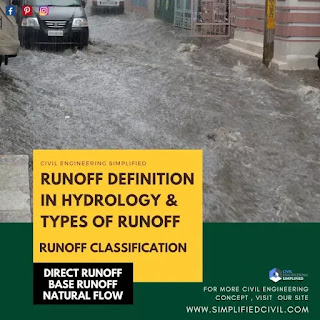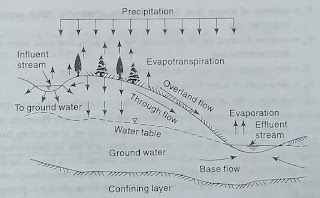 |
| Runoff definition in hydrology & types of runoff pdf |
Runoff definition in hydrology
Runoff means the draining or flowing off of precipitation from a catchment area through a surface channel. It thus represents the output from the catchment in a given unit of time.
Consider a catchment area receiving precipitation. For a given precipitation, the evapotranspiration, initial loss, infiltration and detention storage requirements will have to be first satisfied before the commencement of runoff. When these are satisfied, the excess precipitation moves over the land surfaces to reach smaller channels. This portion of the runoff is called overland flow and involves building up of a storage over the surface and draining off of the same. Usually, the lengths and depths of overland flow are small and the flow.
Also read - Hand signals in surveying pdf
some location away from the point of entry into the soil. This component of runoff is known variously as interflow, through flow, storm seepage, subsurface storm flow or quick return flow. The amount of interflow depends on the geological conditions of the catchment. A fairly pervious soil overlying a hard impermeable surface is conducive to large interflows. Depending upon the time delay between the infiltration and the outflow, the interflow is sometimes classified into prompt interflow, i.e. the interflow with the least time lag and delayed interflow.
Another route for the infiltered water is to undergo deep percolation and reach the groundwater storage in the soil. The groundwater follows a complicated and long path of travel and ultimately reaches the surface. The time lag, i.e. the difference in time between the entry into the soil and outflows from it is very large, being of the order of months and years. This part of runoff is called groundwater runoff or groundwater flow. Groundwater flow provides the dry-weather flow in perennial streams.
 |
| Different routes of runoff |
Based on the time delay between the precipitation and the runoff, the runoff is classified into two categories; as
- Direct runoff, and
- Base flow.
These are discussed below.
Direct Runoff
It is that part of the runoff which enters the stream immediately after the rainfall. It includes surface runoff, prompt interflow and rainfall on the surface of the stream. In the case of snow-melt, the resulting flow entering the stream is also a direct runoff. Sometimes terms such as direct storm runoff and storm runoff are used to designate direct runoff. Direct runoff hydrographs are studied in detail in Chapter 6.
Base Flow
The delayed flow that reaches a stream essentially as groundwater flow is called base flow. Many times delayed interflow is also included under this category. In the annual hydrograph of a perennial stream , the base flow is easily recognized as the slowly decreasing flow of the stream in rainless periods.
Also read - California bearing ratio test procedure pdf
Natural Flow
Runoff representing the response of a catchment to precipitation reflects the integrated effects of a wide range of catchment, climate and rainfall characteristics.
True runoff is therefore stream flow in its natural condition, i.e. without human intervention. Such a stream flow unaffected by works of man, such as reservoirs and diversion structures on a stream, is called natural flow or virgin flow.
When there exists storage or diversion works on a stream, the flow on the downstream channel is affected by the operational and hydraulic characteristics of these structures and hence does not represent the true runoff, unless corrected for the diversion of flow and return flow.
The natural flow (virgin flow) volume in time At at the terminal point of a catchment
is expressed by water balance equation as
Rₙ =(Rₒ-Vᵣ)+Vₔ+E+Eₓ+∆S
where
Rₙ = natural flow volume in time ∆t
Rₒ = observed flow volume in time ∆t at the terminal site
Vᵣ = volume of return flow from irrigation, domestic water supply and industrial use
Vₔ = volume diverted out of the stream for irrigation, domestic water supply and industrial use
E = net evaporation losses from reservoirs on the stream
Eₓ= net export of water from the basin
∆S = change in the storage volumes of water storage bodies on the stream
In hydrological studies, one develops relations for natural flows. However, natural flows have to be derived based on observed flows and data on abstractions from the stream. In practice, however, the observed stream flow at a site includes return flow and is influenced by upstream abstractions. As such, natural flows have to be derived based on observed flows and data on abstractions from the stream. Always, it is the natural flow that is used in all hydrological correlations.






0 Comments